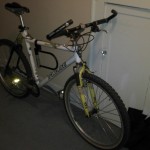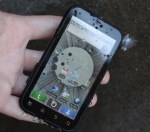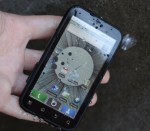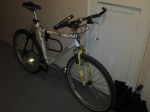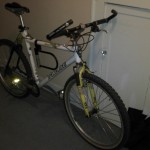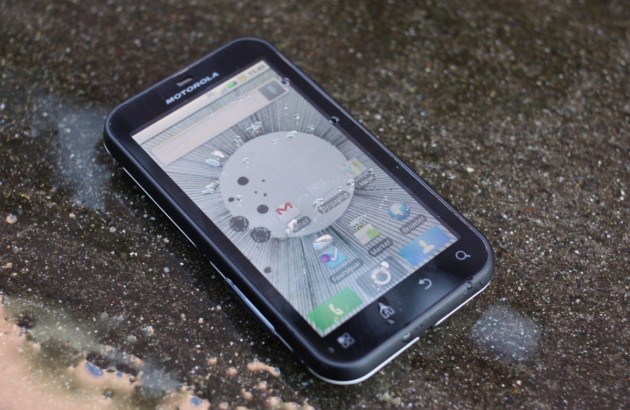
Short version: Waterproof and attractive, the Defy is a solid smartphone with relatively rare selling points. It’s missing Froyo at the moment and MOTOBLUR isn’t for everyone, but I consider this thing a great value.
Features:
- Waterproof and dustproof body
- 3.7″ 854×480 LCD with Gorilla Glass
- Android 2.1 with MOTOBLUR social web widgets and interface
- 800MHz CPU, 512MB RAM, 2GB internal storage, MicroSD slot
- MSRP: $99.99 with new contract (or $49.99 at Walmart)
Pros:
- Light and attractive
- Bright, sharp, good-size screen
- Definitely waterproof
Cons:
- 2.1 and MOTOBLUR chug a little
- Despite rugged nature, feels cheap sometimes
- I don’t trust these little flaps
Full review:
I knew going into this that there would be parts of this handset that I’d like and some I wouldn’t like. But the Defy has surprised me and won me over more than I expected. The truth is, however, that I’m not the target demographic for its social-web-heavy MOTOBLUR interface and widgets, so I may sell those short. However, they’re not much different from any other MOTO phone, so I wouldn’t have lingered on them much anyway. I’ll focus on what’s specific to this phone.
Hardware
The Defy is being billed as “life-proof,” which is a bit of an exaggeration but we’ll forgive them. Their reasoning for calling it that is that it’s weather-sealed, and that’s no lie. The Defy can live underwater for minutes or probably hours at a time, and living in a bag filled with crumbs or dirt is no problem. This eases one’s worries but let’s be honest, most of us have gotten into the habit of protecting our phones from that stuff anyway.
That’s not to say the sealing isn’t welcome. Not having to worry where you put the phone down or what pocket it’s going in is something I could easily get used to. And the screen (covered as it often is with oils from your fingers) sheds water amazingly fast and is very usable even when wet.
The phone is surprisingly light and compact; I don’t know what I was expecting, but with a 3.7″ screen, you kind of expect a certain weight and size. The Defy is a little thick, but not offensively so, and its other dimensions are admirably small. The screen takes up almost the whole face of the phone, with very little bezel and the standard Android touch-sensitive buttons (menu, home, back, search) at the very bottom. Power and headphone jack are on the top, volume buttons are on the right (a little weird), and USB port on the left. The back panel has the five-megapixel camera and flash, and the panel is removable by sliding a mechanism at the bottom, which also works as a seal tightener when putting it back on. There is a single LED at the top left that seems to only have amber and green, but it’s welcome anyway.
The headphone and USB ports are protected by little flaps you must move aside to connect. The headphone one is flexible rubber and seems to make a nice little seal when you press it in. But the USB flap is far less convincing, and reminds me of the one on the bottom of the G1, which broke off after a few months. I doubt this one is quite as fragile, but the way it rotates and the rather weak-feeling seal it makes aren’t heartening. With luck it’s a cheap fix if it does break.
The phone as a whole doesn’t feel “nice,” though, the way the G2 does. Of course, the Defy costs significantly less and plastic is way easier to weather-proof, so this isn’t an oversight exactly, but the lightness combined with the plastic make this feel cheaper than it should. It’s important that I note that it doesn’t feel fragile, exactly, but the buttons and general experience won’t impress anyone.
The duotone look may not be your style but I like it. It makes it look like diving equipment, which I suppose it kind of is.
I love the screen. 854×480 at 3.7″ is extremely sharp, and it’s bright enough to work in bright lighting. The touchscreen was responsive and accurate even when wet (though not underwater), though things didn’t seem nearly as smooth as the G2 despite having similar specs. I blame MOTOBLUR. The keyboard for some reason struck me as a little small, which may just be in my mind, but it and Swype worked perfectly well, so there’s no real complaint there.
Camera
Nothing special here, but nothing wrong either. Five muddy megapixels and a harsh but usable flash, pretty much like any other phone out there. Have some sample shots, my friend:
The center one used the flash, and turned out pretty poorly. There’s actually a good amount of detail in the jade plant and screen, but the lighting was pretty good. I’d say you’re getting about two effective megapixels out of this, which is standard for a camera phone.
Software and performance
The first thing I did when I turned this sucker on was throw away a bunch of the enormous widgets that are on by default. I’m more of a vanilla Android guy, so I can’t hold it against Motorola, but there really is quite a lot of bloatware on this thing. If you aren’t careful, you could end up with two or three channels for every email, SMS, and social web account out there. For a non-savvy user, this could be an extremely confusing experience, and the initial MOTOBLUR setup failed to register my second Gmail address (and then failed to alert me of that failure), something not every user would notice right away.
There’s an improved music app with access to some online services, but it’s still pretty weak compared with the iPhone or third-party apps. It’s good that people are trying to upgrade the player, but Google is the one who needs to step up here, not HTC and Motorola.
My issue is that even if you don’t want or need, say, the “family room” suite of apps (which to its credit detected every member of my family in my contacts automatically), you can throw them away, but they’re still lurking along with the other bloat apps, and you’ll often see them referred to when you’re setting up this or that or adding widgets. The phone also chugs a bit, especially with lots of widgets and apps installed. There’s really no excuse for this when similarly-specced phones offer smooth experiences. Or rather, excuses are running out and phones really should be shipping with 2.2 by this time.
To be honest, this phone would work a lot better with a generic 2.2 install. MOTOBLUR doesn’t do it any favors and it’s not clear why a phone for which the focus is go-anywhere should have a social/family/connectivity focus. On the CLIQ it seemed natural, but this phone seems like it should be loaded with outdoor apps like My Tracks, or have some other rugged-specific stuff on it.
Conclusion
The Defy is a solid phone at a good price (you can get it for $50 if you look), it’s got a great screen, and with luck, 2.2 will be rolling out to the Motorola lineup soon, which should bring some much-needed speed improvements and a few nice standard features. I continue to be unimpressed by MOTOBLUR, but the Defy itself is a great handset. Recommended for the moisture-wary consumer.
Product page: Motorola Defy on T-Mobile




